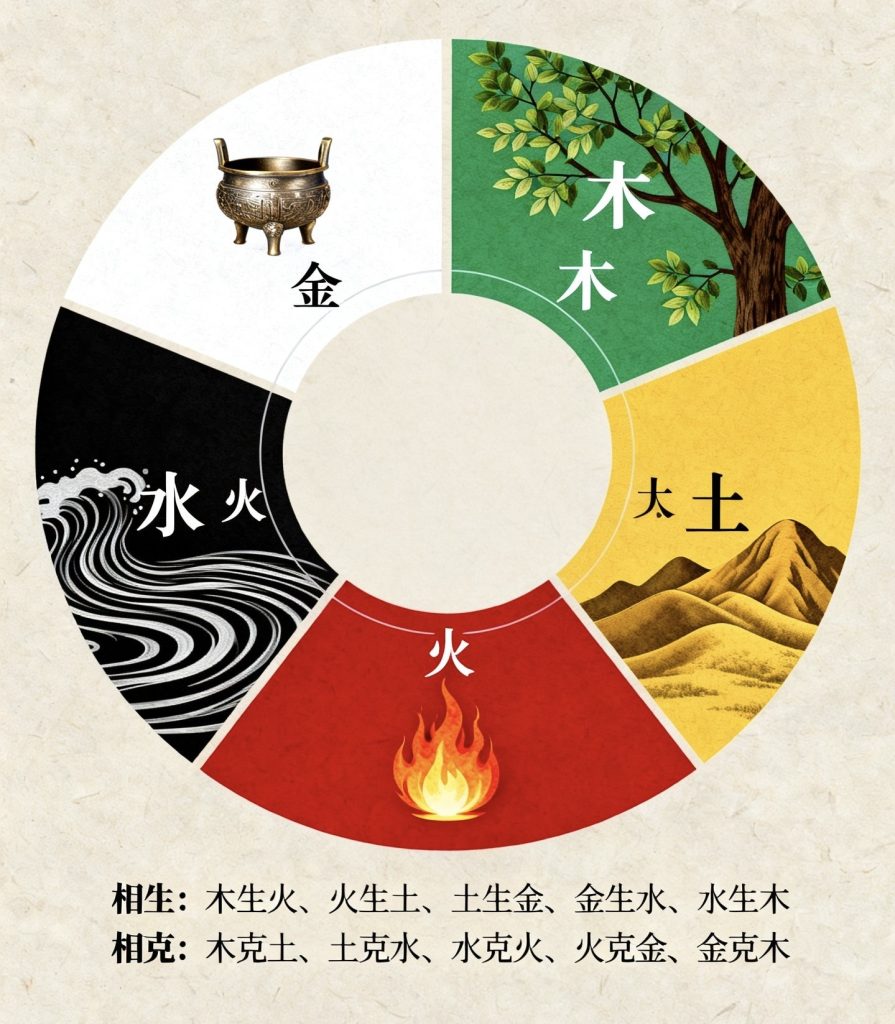The Five Elements theory posits that all phenomena in the universe arise from the interactions and transformations among five fundamental substances: Wood, Fire, Earth, Metal, and Water. The world is a dynamic equilibrium system where the Five Elements mutually generate and restrain one another.
I. Fundamental Meaning of the Five Elements
The Five Elements refer to the activities and transformations among the five forms: Metal, Wood, Water, Fire, and Earth.
Ancient Chinese philosophers employed these five elements to explain the origins of all things in the universe. Traditional Chinese Medicine uses the Five Elements to interpret numerous physiological and pathological phenomena, while traditional Chinese astrology applies the principles of mutual generation and restraint to predict individual destinies.
The Five Elements theory posits that all phenomena in the universe arise from the dynamic interactions among the five fundamental substances: Wood, Fire, Earth, Metal, and Water. It further employs the generating and restraining relationships between these elements to explain interactions among phenomena, asserting that nothing exists in isolation or remains static. Instead, all things maintain harmonious equilibrium through perpetual cycles of generation and restraint. This constitutes the core essence of the Five Elements theory.
II. Development of the Five Elements Theory
The Five Elements theory originated within Daoist thought. It emphasizes holistic concepts, describing the structural relationships and movement patterns of phenomena. If Yin-Yang is viewed as an ancient theory of opposites and unity, then the Five Elements can be regarded as a foundational systems theory.
During the late Western Zhou period, a rudimentary materialist “Five Elements Doctrine” emerged. This evolved from the Guoyu: Zhengyu’s assertion that “earth combines with metal, wood, water, and fire to create all things” and the Zuo Zhuan’s statement that “Heaven produced five elements for all people to share; neglecting one is impossible,” to the Shangshu: Hongfan’s formal definition: “The Five Elements: First is water, second is fire, third is wood, fourth is metal, fifth is earth. Water moistens downward, fire blazes upward, wood bends and straightens, metal yields and transforms, earth cultivates crops. Moistening downward yields saltiness, blazing upward yields bitterness, bending and straightening yields sourness, yielding and transforming yields pungency, cultivating crops yields sweetness.” This marked the beginning of abstracting the attributes of the Five Elements and extending them to other phenomena, forming a fixed combinatorial pattern.
By the late Warring States period, the concept of mutual overcoming (conquest) and mutual generation among the Five Elements emerged, with fixed sequences for both processes. This established a model of interconnected relationships between phenomena, naturally reflecting the inherent structural connections and holistic understanding of things.
It was precisely during this era that the Neijing applied the Five Elements theory to medicine. This played a crucial role in studying and systematically organizing the rich clinical experience accumulated in ancient folk practices, thereby laying the foundation for constructing the unique theoretical framework of Traditional Chinese Medicine.
III. Characteristics of the Five Elements
The Five Elements do not refer to five specific physical entities; rather, they represent five symbols, different states, or qualities.
Characteristics of Metal
Metal embodies righteousness. Metal is described as “following transformation”—following signifies compliance and obedience, while transformation denotes change and reform. Thus, metal possesses the characteristics of being both flexible and rigid, capable of expansion, transformation, and sternness. Metal: its nature is rigid, its nature is fierce.
Characteristics of Wood
Wood governs benevolence. Wood is described as “bending and straightening”—bending signifies yielding, while straightening signifies extending. Thus, wood possesses the nature of yielding and extending. Wood absorbs the energies of water and earth, enabling growth and development. Therefore, wood also embodies the gentle, benevolent qualities of upward growth, elongation, and nurturing. Wood is characterized by its upright nature and its harmonious essence.
Characteristics of Water
Water governs wisdom. Water is described as “moistening downward”—moistening signifies dampness, while downward denotes flow. Thus water possesses the qualities of nourishing moisture, downward flow, and the ability to penetrate and conceal. Water is intelligent and benevolent in nature.
Characteristics of Fire
Fire governs propriety. Fire is described as “flaming upward”—flaming signifies heat, and upward denotes ascension. Thus, fire possesses the nature of generating heat, warmth, and upward movement. It has the power to dispel cold and retain warmth, as well as the ability to temper metals. Fire is characterized by urgency and reverence.
Characteristics of Earth
Earth governs trustworthiness. Earth is described as “cultivating crops”—sowing seeds is cultivation, reaping harvests is gathering. Earth possesses the capacity to bear all things, nurture growth, and store within. Thus, earth bears the four directions, serves as the mother of all things, and embodies the nature of profound contribution. Earth is heavy in nature and thick in sentiment.

IV. Interrelationships of the Five Elements: Generation and Control
In the theory of the Five Elements, generation and control are regarded as natural phenomena. It is precisely through these interdependent relationships that ecological balance is maintained in the natural world.
Generation of the Five Elements
Within the Five Elements theory, generation and control are seen as fundamental to nature. These interdependent relationships ensure the preservation of ecological equilibrium.
Metal generates Water, Water generates Wood, Wood generates Fire, Fire generates Earth, Earth generates Metal.
Wood generates Fire: Fire relies on wood as fuel; when wood is consumed, fire naturally extinguishes.
Fire generates Earth: After fire consumes matter, it transforms into ashes, which are essentially earth.
Earth generates Metal: For metal lies hidden within soil and rock, extracted through smelting processes.
Metal generates Water: For metal, heated by intense fire, melts into liquid—and liquid belongs to Water; Water relies on metal tools for guidance and channeling.
Water generates Wood: For water nourishes plants, enabling them to thrive and grow.
The Five Elements’ Mutual Restraint
The essence of mutual restraint lies in limitation, exclusion, and opposition—where one element inhibits and constrains the growth and function of another.
Metal restrains Wood, Wood restrains Earth, Earth restrains Water, Water restrains Fire, Fire restrains Metal.
Water restrains Fire: quantity overcomes quality, thus water restrains fire, as fire is extinguished by water.
Fire overcomes Metal: Refined substance overcomes solid form. Thus fire can overcome metal, as intense flames can melt metallic substances.
Metal overcomes Wood: Rigid substance overcomes flexible substance. Thus metal can overcome wood, as tools made of metal can cut down trees.
Wood overcomes Earth: Concentrated substance overcomes dispersed substance. Thus wood can overcome earth, as the roots of trees are strong and can penetrate soil.
Earth overcomes Water: Solid overcomes the void, so earth can overcome water, as soil can absorb and block water flow.
V. Prosperity, Strength, Rest, Imprisonment, and Death
“Prosperity” indicates the state of peak vigor;
“Strength” indicates a relatively vigorous state;
“Rest” indicates a state of stillness or repose;
“Imprisonment” indicates a state of weakness or constraint;
“Death” indicates suppression, with vitality entirely depleted.
The Five Elements cycle through the four seasons, thus Wood, Fire, Earth, Metal, and Water persist throughout the year. Due to seasonal transitions and shifts in temperature, dryness, and humidity, the Five Elements undergo cyclical fluctuations in strength and weakness influenced by the natural environment. What is vigorous will turn to weakness, and what is weak will turn to vigor—this cycle is endless. Moreover, because of the interdependent and restraining relationships among the Five Elements, their relative strengths vary within the same period. At any given time, only one element is at its peak of vigor, and only one is at its lowest point of weakness.
Based on the above summary, we can discern the following patterns: The season in its prime is vigorous; What it generates is in harmony; What generates it is at rest; What it overcomes is restrained; What it overcomes is exhausted.
For example, using Wood as an illustration: Spring is the season when Wood is in season, so Wood is strong; Fire is generated by Wood, so Fire is in harmony; Water, like the mother who nurtures Wood, now that Wood has grown strong and vigorous, the mother can step aside, so Water is at rest. Spring Wood is vigorous, and Metal is no longer strong enough to overcome it, so Metal is subdued. Earth is overcome by Wood; now that Wood is in season and its energy is strong and vigorous, Earth is overcome.
In practical application: If someone born in spring has Wood as the dominant element in their BaZi, it is considered in season and timely. If Metal is dominant, it is in a state of confinement and untimely. Other elements follow this principle accordingly.
